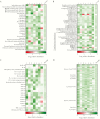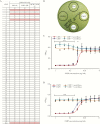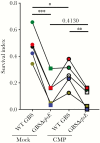Human Cervical Mucus Plugs Exhibit Insufficiencies in Antimicrobial Activity Towards Group B Streptococcus
- PMID: 29425317
- PMCID: PMC5913629
- DOI: 10.1093/infdis/jiy076
Human Cervical Mucus Plugs Exhibit Insufficiencies in Antimicrobial Activity Towards Group B Streptococcus
Abstract
Preterm birth is a leading cause of neonatal mortality and lacks an effective therapy. Ascending microbial infections from the lower genital tract lead to infection of the placenta, amniotic fluid, and fetus causing preterm birth or stillbirth. Directly in the path of an ascending infection is the cervical mucus plug (CMP), a dense mucoid structure in the cervical canal with potential antimicrobial properties. In this study, we aimed to define the components of CMP responsible for antimicrobial activity against a common lower genital tract organism associated with preterm birth and stillbirths, namely, group B streptococcus (GBS). Using a quantitative proteomic approach, we identified antimicrobial factors in CMPs that were collected from healthy human pregnancies. However, we noted that the concentration of antimicrobial peptides present in the human CMPs were insufficient to directly kill GBS, and antimicrobial activity, when observed, was due to antibiotics retained in the CMPs. Despite this insufficiency, CMP proteins were able to activate leukocytes in whole blood resulting in increased rates of bacterial killing, suggesting a role for the CMP in enhancing complement-mediated killing or leukocyte activation. This study provides new insight into how the human CMP may limit ascending bacterial infection.
Figures





Similar articles
-
Bacterial Hyaluronidase Promotes Ascending GBS Infection and Preterm Birth.mBio. 2016 Jun 28;7(3):e00781-16. doi: 10.1128/mBio.00781-16. mBio. 2016. PMID: 27353757 Free PMC article.
-
Matrix metalloproteinases in the cervical mucus plug in relation to gestational age, plug compartment, and preterm labor.Reprod Biol Endocrinol. 2010 Sep 24;8:113. doi: 10.1186/1477-7827-8-113. Reprod Biol Endocrinol. 2010. PMID: 20868473 Free PMC article.
-
Eradication of intra-amniotic Streptococcus mutans in a woman with a short cervix.J Obstet Gynaecol Can. 2006 Oct;28(10):898-902. doi: 10.1016/S1701-2163(16)32269-1. J Obstet Gynaecol Can. 2006. PMID: 17140507
-
[Idiopathic preterm delivery and subclinical genital infection].Ugeskr Laeger. 1991 Apr 29;153(18):1260-2. Ugeskr Laeger. 1991. PMID: 2028537 Review. Danish.
-
Antibiotics after preterm premature rupture of the membranes.Clin Obstet Gynecol. 2011 Jun;54(2):344-50. doi: 10.1097/GRF.0b013e318217ec5d. Clin Obstet Gynecol. 2011. PMID: 21508705 Review.
Cited by
-
Engineering monoclonal antibody-based contraception and multipurpose prevention technologies†.Biol Reprod. 2020 Aug 4;103(2):275-285. doi: 10.1093/biolre/ioaa096. Biol Reprod. 2020. PMID: 32607584 Free PMC article. Review.
-
Different Forms of TFF3 in the Human Endocervix, including a Complex with IgG Fc Binding Protein (FCGBP), and Further Aspects of the Cervico-Vaginal Innate Immune Barrier.Int J Mol Sci. 2024 Feb 14;25(4):2287. doi: 10.3390/ijms25042287. Int J Mol Sci. 2024. PMID: 38396964 Free PMC article.
-
The Cervicovaginal Mucus Barrier.Int J Mol Sci. 2020 Nov 4;21(21):8266. doi: 10.3390/ijms21218266. Int J Mol Sci. 2020. PMID: 33158227 Free PMC article. Review.
-
Antimicrobial Peptides in Early-Life Host Defense, Perinatal Infections, and Necrotizing Enterocolitis-An Update.J Clin Med. 2022 Aug 29;11(17):5074. doi: 10.3390/jcm11175074. J Clin Med. 2022. PMID: 36079001 Free PMC article. Review.
-
Host Cathelicidin Exacerbates Group B Streptococcus Urinary Tract Infection.mSphere. 2020 Apr 22;5(2):e00932-19. doi: 10.1128/mSphere.00932-19. mSphere. 2020. PMID: 32321824 Free PMC article.
References
-
- Nold C, Anton L, Brown A, Elovitz M. Inflammation promotes a cytokine response and disrupts the cervical epithelial barrier: a possible mechanism of premature cervical remodeling and preterm birth. Am J Obstet Gynecol 2012; 206:208.e1–7. - PubMed
Publication types
MeSH terms
Substances
Grants and funding
LinkOut - more resources
Full Text Sources
Other Literature Sources
Medical
Molecular Biology Databases

